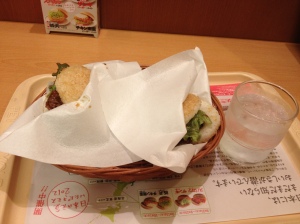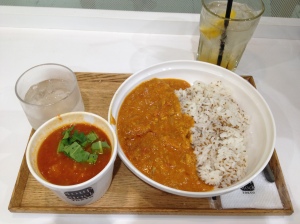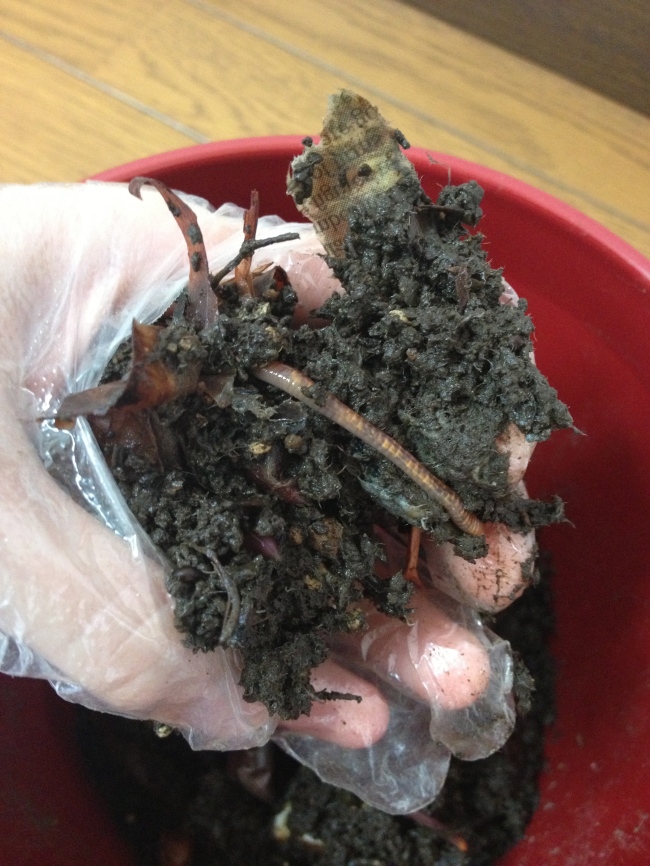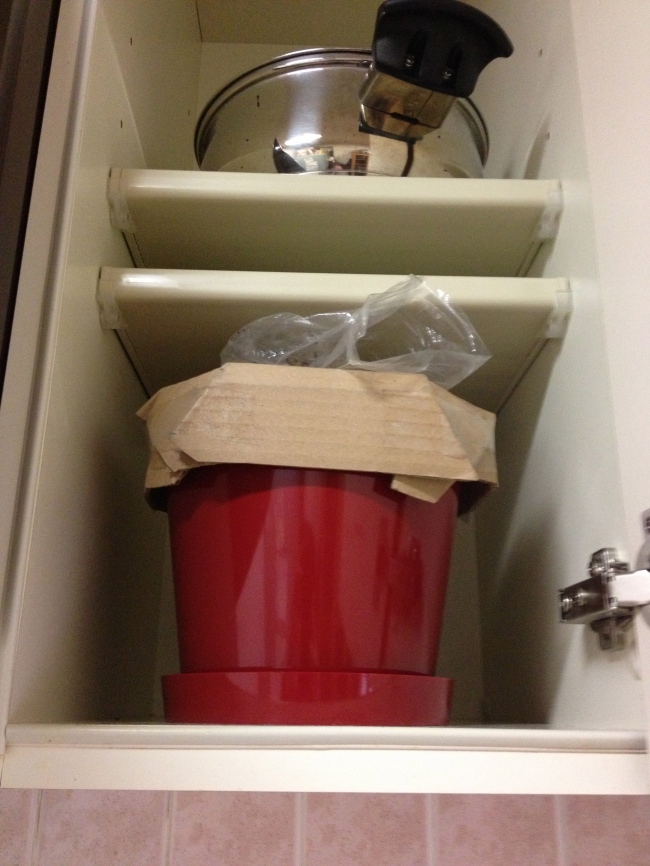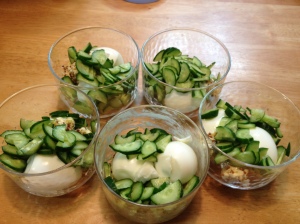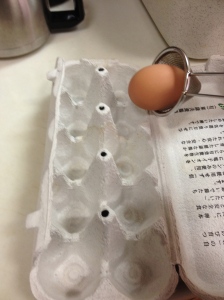“What will they think of next?” This country with so many unique inventions came up with a machine that makes bread out of rice! Some friends gave us one as a wedding present and I was so excited to use it.
Of course, the directions are all in Japanese. I don’t think they’ve realized they would have a strong market for this in the US! As my husband went through the directions we discovered there are only a few recipes that are completely gluten-free only, but a few was all we needed. I don’t think any of the recipes actually included rice turning into bread like in the video (around 36 sec) but turning rice flour into bread is good enough for me.
We followed the recipe exactly and while the ingredients are probably similar to what I’d eat if I bought gluten-free bread in a store somewhere, many (like vegetable oil) weren’t ones I’d include if I were making my own healthified food at home. Here’s our first, pretty pathetic-looking attempt at bread:
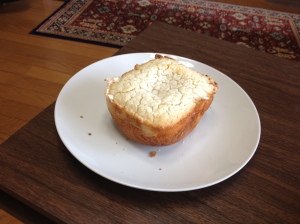
Our first attempt at gluten-free rice bread made in the Gopan. Rather short. And not quite the crusty top you might want.
It was still edible. For me. But not really a success. We tried it a few more times and got the ingredients to mix together better, but with our busy schedules and my inability to actually read the directions, we didn’t get much more bread made while in Japan. Currently our machine is in storage while we’re traveling, but I’m looking forward to experimenting with it again in a year. I hate wasting ingredients since I certainly don’t have a fool-proof paleo-ish bread recipe, but I’ll have to try a few out once we’re reunited.
Anyone have a favorite recipe? I’m not a huge fan of nut-based paleo breads — if I’m eating bread I want a decent amount, and too many almonds expand to feel like rocks in my stomach. So if you have a great gluten free bread recipe that doesn’t rely on nut flour, canola oil, or xantham gum, I’m all ears. I love how tapioca makes things sticky so that’s probably what I’ll experiment with.
Since committing to going gluten free in 2010 I had been vigilant about trying not to ingest even a crumb of it. There were mistakes, like the time I ate some red vines, but by avoiding it nearly all the time I found I did not react to small exposures like the amount in red vines or even soy sauce (which may have next to no wheat left in it).
So I wasn’t sure how things would go once I moved to Japan. A lot of Japanese cuisine is naturally gluten free, but I’ve heard the rice-focused nation began using more and more wheat in the twentieth century (What’s the history of tonkatsu?). Every grocery store I went to had a bakery section. So while it’s relatively easy to order food that’s naturally gluten free (at least minus the soy sauce), if you lack the language skills to double-check it can be hard to know for sure there’s no gluten hiding somewhere in your food. For example, miso soup can be gluten free or not, depending on how it’s made. Probably because people’s day-to-day cuisine is pretty gluten free, or maybe due to genetic variance, few people have celiac disease and the term “gluten free” is virtually unheard of, even in cosmopolitan Japan. So with all these caveats in mind, the advice I have to give is probably most useful for someone who is does not have celiac disease and is not overly sensitive to gluten. But maybe it can benefit some of you with celiac disease, particularly with knowledge of Japanese or access to a Japanese speaker.
Convenience Stores: I spent my first month in Japan without my Japanese-speaking husband, so the quickest and simplest way for me to get food was to go to a convenience store. Unlike most New York bodegas, you can fill up on pretty healthy stuff at Family Mart or 7-Eleven. When I snacked In New York I usually relied on Lays potato chips but Japan has something called onigiri. They are a delicious, ingenious invention — meat or vegetables (or pickled plum) bundled in a rice triangle and wrapped with seaweed. Spend about a dollar and you have a filling snack. Those with limited reading abilities should rely on the ones with pictures on the front or the see-through bags.
Convenience stores or mini grocery stores often have sushi, as well. Pretty good sushi, I’d have to say. Now I spoke to people who’d been around Japan awhile who claimed things like “They use the bad, radioactive fish in convenience store food” or someone whose wife’s friend worked in a factory and explained all the chemicals they spray on the rice to keep it so fresh. Who knows for sure? I’m certain it’s not the highest quality ingredients, but you can spend hundreds of dollars on sushi. I’m sure convenience store sushi is not as good in comparison, but it tastes good and it’s filling, and I’m sure it’s much healthier than potato chips (what kind of chemicals are sprayed on food that’s preserved almost indefinitely in a bag??). One thing I actually like about Japanese stores is they run out of goods: freshness is really important there, so they’ll only put a few of a particular variety on the shelf and when it’s gone it’s gone. So maybe it’s not as healthy as freshly fallen snow, but I’ll take my chances.

It’s easy to pick up decent sushi. Not pictured: many convenience stores also sell soft-boiled eggs.
Mos Burger
The second establishment I visited all throughout August 2012 was Mos Burger. They have a few burgers on the menu with rice buns! Literally, rice crushed together into the shape of a bun. I think I had my husband ask them, but you never know for sure if a random fast-food chain employee knows how the buns are made. So celiacs beware. But I loved the taste. In 2013 they changed the menu, now offering three burgers, but I think one was filled with breaded chicken. The ones I would order were the fish or the root-vegetable filled ones which were fine, but not as good as the beef I used to get. So I’m not sure how they’ll change the menu next, but I predict the rice bun will stick around, as I first tasted it on a visit in 2009.
By the way those wrappers help contain your burger, or hide your open mouth like in the Freshness Burger ad campaign.
Soup Stock
Another great place to visit if you lack Japanese skills is Soup Stock. I love it so hard. Fast, yummy soup! I presume they use real stock, which I believe is an essential life ingredient. And the soup comes on a wooden tray in ceramic bowls (I love that hipster aesthetic). The picture menus at the door list common allergens (wheat, milk, eggs) at the bottom in English and Japanese. I would caution that occasionally I think some the soups contain cooked barley. I’ve had the same issue with some rice in convenience stores. So keep an eye out for these grains if they’re an issue for you.
Muji’s cafe
A place with similar aesthetic but where you might need a Japanese speaker is the basement of the hipster home-goods store Muji located in Shinjuku next to a movie theater.

Food from Muji’s cafe. You can reserve your seat there with, ironically, the symbol for wheat. Or water, or another more pleasant character.
They have a wide variety of foods in their deli, which they will delicately plate for you, but the list of allergens is written in a very small font, and it can be awkward to pick out food when it’s a really crowded day.
Izakayas
A general type of establishment you can eat at is an Izakaya. The menus often have pictures and a wide variety of small foods to share, so you should be able to find sushi, or meat on a stick, or vegetables to fit your needs.
Finally, I got most of my food at the grocery store. There was also a health food store I randomly found near Takadanobaba that sold these beauties (kind of like nilla wafers):
Another grocery store that caters to foreign needs is National Azabu; I think I found hard cider there, but I lived far enough away that even if they’d had gluten free frozen goods I couldn’t take them home. Costco was the same for me. I also ordered raisins, spices and random health-food items online from Alishan. Finally, I think a lot of expats get things from the Foreign Buyer’s Club. I just mostly went without soft cookies and bread while in Japan; there are plenty of other delicious foods to be eaten (Ice cream, chocolate and Macrons work for me!).
A few more thoughts on eating gluten free in Japan:
Sneaky foods: you may have heard soba noodles are made with buckwheat. Yes, traditionally, but like the rest of the world, when it found out gluten is sticky, Japanese people began mixing wheat into most of their soba noodles. I’m not a huge fan of the cold soba noodles you can get in restaurants anyway, but if you’re looking for a quick, grainy-tasting pasta substitute, often there’s one brand in grocery stores that says 100% buckwheat on the front. Also, I initial thought this thing called a Hamburg would be perfect for me since it doesn’t come with a bun. However, it’s a patty made with panko, or breadcrumbs. A lot of places (like the mall restaurants) will have Doria, a rice gratin. It looks really good but since it’s based on French cuisine it looks like most recipes include flour in order to make a white sauce.
Like in the US, the fancier the restaurant, the more likely it is they may have heard about gluten and know how to handle it. The chefs are well trained and are adding all the ingredients themselves, so they know how to leave things out or use substitutions. Fast-food employees are less likely to know what’s in the food they’re cooking. Service in Japan is amazing; people often make you feel like nothing would make them happier than to serve you your heart’s desire. But because they try so hard to please, they worry when they hear “allergen.” We had a few experiences where we asked whether or not a food had gluten in it, and because the server couldn’t say for sure, they didn’t want to serve me. I understand they don’t want me to die, and ordinarily I might appreciate this; celiacs might find this particularly helpful. However, it led us to just google recipes for things and make our best guesses, rather than burden people with questions.
Dealing with food restrictions in a foreign language is tough, but it was ultimately a useful experience for me. I discovered I didn’t have to live as carefully as a celiac in order not to get sick, so I needn’t worry as much when I ate out, and I became more appreciative of how easily I can ask servers about food in the US the few times I did eat the wrong thing. If you’re a gluten avoider or you love someone who is then I hope this list will help you when visiting Japan.
We left Japan in June. There was so much I wanted to write here about our experience, but with full-time teaching and commuting I didn’t get around to it. So as I blog in the future I may post about places I have ties to but I’m not currently living in (we moved to Brazil this summer, but I may post about NYC sometimes, too).
One silly post I’ve wanted to write for awhile is about two Japanese products I love: 1) erasable pens and 2) black cotton swabs (they are q-tips in my mind, but I suppose that’s really a brand name).
I’ve always been a pencil person. I love the feel of the wood in my hand, the process of sharpening my tools before I start, and most of all the ability to change my mind and erase things. My thoughts are not necessarily linear and complete when I put them down on paper! So I always figured I’d be a pencil person for life: teaching easily assimilates such people. However, Japan has erasable pens! I know these must exist in the US but the Pilot Fixion Ball pens are really effective. You can get all kinds of colors and pen sizes, including ones that write as thinly as any pencil. You can buy ink refills so at least you can reuse the main part of the pen. When you erase you don’t get annoying eraser crumbs like you do with some pencils — the rubber or plastic ends just makes it disappear like magic. Perfect for thank you cards.
Students I’ve taught in China and Japan have serious writing utensil collections in their pencil cases, and kids in Japan seem especially well-stocked with these options. You can probably buy these elsewhere as well, but I always got them at Tokyu Hands.

Basement entrance with elevators. There’s a sweet cafe on the top floor and all kinds of random things to buy on other floors.
Japanese Invention #2:
Have you ever seen cotton swabs that are anything but white? There’s nothing better than a good ear cleaning when they’re feeling itchy or uncomfortable, and it seems like ear cleaning is even more highly valued in Asia. Though I’ve never been to a professional, I’ve seen old men sitting on chairs in parks in China while practitioners clean their ears with special tools. Tokyu Hands sells ear-cleaning electronic tools, including an expensive one with video so you can see what’s happening inside your ear. They really do not mess around. So I shouldn’t have been surprised that they would give you options when it comes to cotton swabs, but coming from a country that only seems to make white ones (can anyone find another color? I’d love to order it) I find this awesome. See, I’ve read there are two kinds of ear-wax: wet and dry (This link may tell you more than you’d like to know, and also seems to get my ancestry wrong). I seem to have the dry kind, so excuse the possibly gross image, but if you use a white cotton swab you can’t really tell if you’re making any progress freeing earwax. Not only is this color better for me, they’re also thinner than the US ones usually are, which I find more effective (though they’re probably just trying to protect our ear drums and avoid law suits) and they come with different shapes on the ends, like you can see here. A word of caution if you’re in Japan — I wouldn’t buy the ones from the 100-yen shops. They seem to be a lot weaker than ones you can get in regular drug stores.
So there you have it. If you want to give me a gift from Japan, bring me black cotton swabs, because I’m nearly out. And maybe refills for my erasable pen. If you’ve lived in abroad, any inventions that were new to you and made your life better?
Pull up a chair for a snack.
We don’t have an oven here so my old standby of baked apple isn’t possible. This is my easiest quick snack that’s somewhat similar.
1. Dice your apples
2. Cut thin slices of butter
3. Sprinkle with cinnamon
Enjoy!
Some people might ask why so much butter? As you can see in my old egg salad breakfast post, I’m not scared of butter (though that breakfast got heavy and I eat a simpler one this year — I’ll post it at some point). Read up on the Paleo Diet or Weston A. Price diet for a comprehensive explanation. My simple explanation is that apples are sweet, and without an accompanying fat they’ll spike my blood sugar and make me hungrier later.
You can even melt your butter for an closer approximation of a baked apple.
 I’m not a fan of the design on our plates, but they were free! Free dishware is always nice when you’re living somewhere temporarily.
I’m not a fan of the design on our plates, but they were free! Free dishware is always nice when you’re living somewhere temporarily.
I was recently checking out dogonews as a possible news source to use with my students when I saw an article about Empower Playgrounds. These are playgrounds (or maybe just merry-go-rounds?) that a group started in Ghana to harvest energy. The energy can then light LED-bulbs around the school and the children can take these lamps home to allow them to study at night.
I love the idea of children using play to create energy. But do Americans have to focus on other countries? While it’s great to help others, it’s not like we have it all figured out at home. America in general is wealthy, but we won’t stay that way by squandering our resources. Why burn coal to power park light-bulbs if children’s play could do it? Using play to generate energy in the US also fits with my understanding of frugality. You can’t sustain wealth by splurging on everything, so the less the US spends on energy the better. Why not create a method of energy creation that is sustainable so we can spend that money and resources in other ways?
Reading about these practical applications makes me wish I had a stronger background in science. For example people have told me windmills just aren’t practical because they don’t generate enough energy. Yet it seems to me like a sustainable energy future will require us to use a variety of sources; so while windmills don’t steadily generate enough energy on their own, combined with other sources it can significantly offset coal or nuclear. If I had a science background I could make this change happen by making windmills or making energy-generating equipment, or at least talking more intelligently about it.
I’m also sure an energy generating playground doesn’t make sense in every situation, and it doesn’t make sense to start pulling apart current playgrounds to install these. But what about new playgrounds going in? What about playgrounds that are worn-out and about to be replaced? Maybe this seems like too trivial of an issue for people to get behind, but what if they did and laws were passed so every new building project was required to consider an energy-generating model, or required to explain why they couldn’t make their project energy-generating?
One more play-energy generator I’ve found: a soccer ball. You kick it around and it powers a lamp to use later. Perhaps not as necessary in the US, but I’m sure there are even places or times at home where it would be useful.
Finally, it doesn’t have to just be about play. Remember the big intersection Scarlett Johansson crosses in Lost in Translation? Shibuya apparently gets 2.4 million people crossing it per day. Perhaps Times Square or other major intersections get similarly high traffic. What could engineers do to collect energy from all that foot pounding? I’m sure it could at least power some lights, if not more.
Are any of you from places where they have installed energy-generating playgrounds or other practical devices? I’d love to find out if any of this is happening in the US, or in other places you’ve been.
I’ve had an enjoyable little stint in the USA this summer, which ends Wednesday when I fly back to Japan. One of my goals this summer was to try to clean up some of my old belongings in my parents’ house. They moved while I was in college and some of my things are still in boxes! (They’re mostly things like My Little Ponies, but still).
Are you one of those people who has an easy time disposing of things you no longer use, or do you keep nearly everything? I would say I grew up with one parent who saved everything (“That cheese hasn’t gone bad! Just cut off the mold”) and one parent who threw everything away (“I’ve read this card so now I’m recycling it.”) Despite equal influence somehow I seem to have become a saver. I guess it seemed nicer. Less ruthless. But in the end it isn’t particularly nice as you end up with so.much.stuff.
A few years ago I read It’s All Too Much and Unclutter Your Life in One Week. Somewhere in my reading I was reminded of the idea that you can’t take it with you. I’m young but who knows what could happen to them? People are in car accidents, plane crashes, etc. (cross fingers) all the time. I would hate for people who I presume would be quite sad to then have to go through my belongings and have to decide what’s important and what’s trash — a task I’m already finding hard enough.
One reason I find it so difficult is I hate waste. You can tell by the way I love the efficiency of composting (trash becoming fertilizer to create new life!). So many of these things I own will simply become trash once I’m done with them. Now, this doesn’t mean I should hold on to them and allow them to become dust collectors and spider nests. But, for example, what to do with those trophies? A few I’d like to keep for memories, but I don’t need all of them. I remember running those races and I’ll fondly remember track and cross country without the participation ribbon to prove it. Is there anyone who recycles trophies? If not these seem like the biggest waste of time, money, and resources. They could have just recognized us with a handshake and photograph. Traveling trophies for championships sound like the way to go.
The more I travel the more I realize how much easier it would be if I had fewer belongings. Little by little I think I’m getting there, but it’s hard to overcome a lifetime of being a saver and “I’ll keep that just in case”-er. I’m lucky enough to have parents who will let me store things in their basement while I travel, but one day a decision must be made! One day when I have a house will I move all these things to it and decide then? I was able to jettison a few things this summer but I made a lot less progress than I had hoped.
Are you a saver or an unclutterer? Any advice for me in this decluttering process?

Reaching into my little compost pail. On the right is the cardboard lid I made and punched a few air holes in.
My family has composted as far back as I can remember. We had this bland old plastic jug, probably once used to store juice in the fridge, which we lined with a paper towel and filled with food waste: egg shells, apple cores, banana peels, vegetable remains. Then when it was full someone would have the unpopular chore of taking it outside and dumping it in the designated area. We always had a pile there, which we would mix with grass clippings and old leaves and would occasionally rake over to mix up the ingredients. Then when it came time to try growing vegetables in the spring we’d spread some of the dark dirt from the bottom of the pile into our small garden.
Most of my friends didn’t have compost but I was probably in high school before I noticed this. Compost was just a normal part of life for me, and while sometimes our jar in the kitchen smelled a little bad, it was nothing worse than the regular trash can.
If you are one of those “normal” people who grew up only using a trashcan and can’t comprehend compost, composting is great for gardening, and much better for the environment that packaging your waste in plastic and sending it off either to sit in a landfill or be incinerated. I think it’s unsurprising that Story of Stuff creator Annie Leonard became interested in trash when she was living in New York city; when people are packed into tight spaces you can see up close how much waste we all produce. Although most people don’t have space to compost outdoors in cities, they do have space for vermicomposting.
In 2011 I attended one of New York’s composting workshops to find out what the deal was with vermicomposting. This is a nicer way of saying “composting with worms.” The workshop was great, but I wasn’t ready to jump right in. I sat on the idea for awhile, and then one day I ended up discussing worm bins with my officemate and realized she was really interested in them too. We decided to go for it. She got the worms and the tub (they sell large plastic shoebox-like tubs with holes punched in them) at the Union Square Farmer’s Market. We went to the park and set it up, and then I kept it at home for awhile while we got it going. Keeping the moisture level right is essential. We were pretty worried about what would happen if it didn’t work out, though we said we could always just dump out the contents behind a tree in the park and walk away if things got out of hand. From the mistakes we made I soon realized we didn’t need to worry too much. Early on I made it too moist and the worms tried to get away by crawling out the holes. I discovered things that looked like twigs outside the box a few days later — it turns out worms, like vampires who die in daylight, can’t exist outside of a dark, wet environment. They just dry up. So while I felt bad several of them died, it wasn’t like they were going to crawl out and take over my apartment — they died close by the bin. Eventually I carried the large box to work (it’s a very awkward size for the subway, though it does fit perfectly inside an IKEA bag) and we kept it under a desk, adding apple cores and my ridiculously large stash of pistachio shells (apple cores are like worm candy, but pistachio shells take years to break down). We neglected it a bit after awhile, and eventually noticed it smelled like a forest. It was a pretty nice smell, but when you lifted the lid there certainly was that foresty smell that hadn’t been there before. We also hadn’t seen any worms in weeks. At some point we combed through carefully and it turned out it must have been too dry and the worms had died off. My officemate bought more worms and we started again.

A picture of our compost my officemate took. You can see the blue IKEA bag showing through the bottom, and leaves we mixed in from the park. Look at those healthy worms!
When I moved to Tokyo I figured my vermicomposting days were behind me, at least for now. Where would I find red wigglers here? Then I discovered another teacher I worked with kept vermicompost in her classroom, leftover from a teacher several years previous who had ordered the red wigglers and had compost set up school-wide. I tried to do the same on a smaller scale but it takes a lot of buy-in from everyone to really make it work. It’s probably not the best project to undertake your first year. So we kept it in the classroom, but didn’t interact much with the worms, and now I’ve taken what was left of them home. I bought a little red gardening container with preformed holes at the bottom and an attached dish for drainage from Franc Franc. I didn’t think my husband would be pleased if the worms took up a lot of space in our little apartment. Then I put a little newspaper in the bottom, the worms and their “dirt” in, along with apple cores and tea bags. Now I just put some scraps in whenever I think about it; usually once a week. It’s been really moist lately.
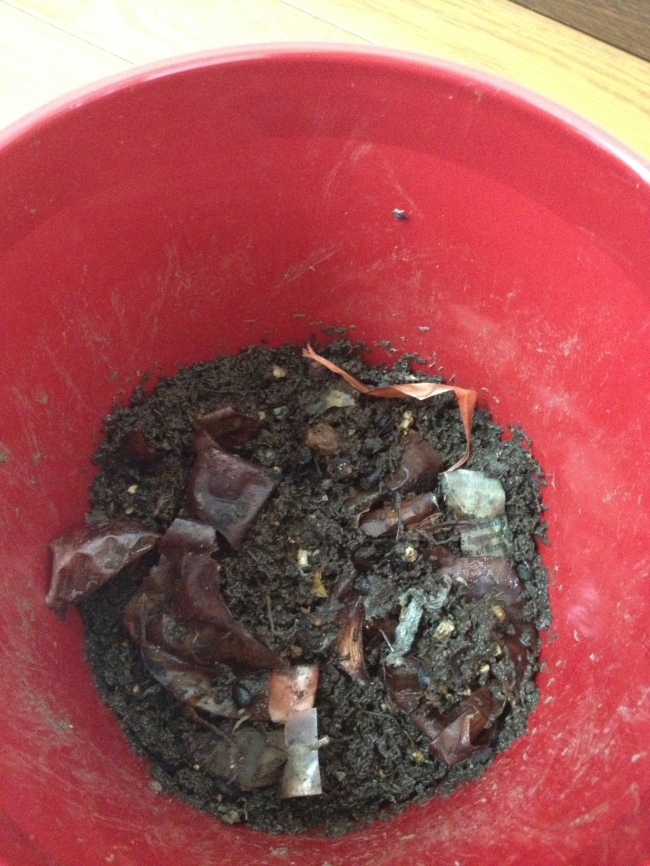
I put a lot of dry onion scraps in as brown matter this time, instead of leaves.
It’s small enough it can’t take all of our kitchen scraps. You never want to have excess plant matter sitting on top for long periods of time — it can mold. Some potential contributions, like bananas, I don’t like to put in anyway because I think it’s more likely to breed fruit flies (though there’s a dearth of fruit flies in Japan. Do they spray more or something?) and others, like onion, really should be going into the freezer for making stock. But I like creating fertilizer for my lonely plant and having something living in my cupboard. It’s nice to keep in the practice of composting, no matter how small the scale.
Do you compost? Any tips for me?
I love to wear sweaters. But they have an unfortunately habit of “pilling.” Perhaps there’s a better word for this, but they’ll get fuzzy after enough wears and washes and start to look old. At one point I tried one of those “lint removing stones” — it’s like a pumice stone –but I didn’t find it very effective. I was complaining about this problem one day to my husband and he said there was a tool his mother always used to just shave them right off. Maybe everyone and their mother already knows about this, but it was news to me. I bought it off of Amazon and loved it dearly, even though it came from Japan so I couldn’t read any of the directions. The directions really weren’t that necessary — it just needed batteries — and then it let me shave my sweaters to look like new whenever they required it.
I only brought two suitcases to Japan so the shaver didn’t make the cut (ahem). As much as I hate buying plastic we were moving to the country that created it. This time we bought it off Amazon.com.jp. My new shaver plugs into the wall, which makes it a little more awkward but perhaps greener. I think it may be louder than my old one (I don’t remember the brand) but it works just as well.
Here’s an example of a sweater that’s started to pill.
All better!
Recipe
1. Two hard boiled eggs per breakfast
2. One fifth of two long (Japanese) cucumbers cut into very thin slices
3. Perhaps a tablespoon of butter per container whipped with grainy mustard
4. Enjoy
For most of my life, say about twenty years, I enjoyed cereal for breakfast every morning. I’m definitely a creature of habit, and I loved waking up and pouring the contents from the box into my bowl, then drenching it with milk. When I was younger it was honey nut cherrios. Later it was raisin bran or frosted mini wheats. In terms of convenience, cereal can’t be beat.
I’ve never had the best digestion, but after living in Beijing for two years my system was really messed up. I had probably last thrown up in elementary school, but there it seemed, particularly in winter, that I had near constant nausea, and sometimes I would throw up several times in one month. Sure, Norovirus went around, and probably not everything I ate was either cooked sufficiently or of the highest quality (the milk scandal happened while I was there), but I thought there could be something more to it, particularly as I would sometimes also get wrenching pains in my stomach. My mother has celiac disease and while a blood test after college said I didn’t have that, I thought I might as well cut down on gluten. Plus, I discovered cereal was really expensive in New York, and when I first moved back I didn’t have a job. Gluten free cereal is even more expensive. I started with gluten free cereal, then switched to yogurt with nuts, and was pretty happy with that for awhile.
But then I got a job and had to be somewhere early in the morning. I had also started reading more about nutrition and was reconsidering how sweet breakfast needed to be. So now that I’ve come untethered from a cereal breakfast I have yet to find the perfect breakfast solution. This one here is pretty satisfying and leaves my stomach happy, but when I eat breakfast around 7:40 and lunch at 12:20, and watch others eating snacks in between, it doesn’t always keep me for all that time. I may need to add more butter, or eat some other snack more satisfying than a carrot. Other breakfasts I’ve tried in the past include the Primal Breakfast Casserole (very convenient to make ahead, but a little much first thing in the morning), smoothies (I may go back, but I can’t decide how much yogurt [dairy] I want to eat, and some combinations again sit funny first thing in the morning, or are overly sweet).
This breakfast started out more simply. For a long time I just quickly ate two hard-boiled eggs for breakfast, sometimes with salt or some other topping like garlic powder. Sometimes, after seeing my Chinese student once happily chomp a cucumber for her breakfast when she arrived late for school, I would add a hunk of cucumber to it. Sometimes I also had a hunk of carrot. This is slightly more complicated, but not too difficult, and particularly because I just break the egg up with my spoon when I eat it all together, it doesn’t take too long to prepare (for awhile I was chopping the eggs into slices. Big mess).
So if you’re looking for a new, tasty breakfast idea that travels well, this just might be your answer.
Broken down:
1. Hard-boil ten eggs. Cover them in water (and perhaps add baking soda — I’ve heard it makes them easier to peel), bring the water to a boil and immediately turn the heat off, then let them sit for roughly seventeen minutes.
2. Stop the boiling process. I’ve read to put them in ice cubes. I’m lazy and after I put them in a container I put them in a freezer, but have discovered I have to set a timer (about half an hour). I always think I’ll remember on my own and don’t, and end up with weirdly frozen eggs. They taste watery and smell bad when they defrost.
3. Get some butter out so it will raise to room temperature, so it’s easier to whip. I go through the process of making the breakfast the next day, as I’ve found the eggs are easier to peel if I’ve waited a day. Haven’t tried it yet with baking soda — maybe I won’t have to wait a day.
4. Cut up the cucumber.
5. Peel the eggs. I’ve heard this technique works for people but I have not been able to get it to work. However I still poke holes in each end and blow on it because it seems to loosen it up, and I can often pull the peel off in big chunks. Yes, it is entertaining to watch me make my breakfast.
6. Whip the butter. I recently got a small food processor so I suspect that works better, but for now I’ve just been mashing it.
Adding mustard, yum.
Five days’ worth all mixed up.
7. Add it all together and discard remnants.
Breakfast is served!
What do you eat for breakfast?



